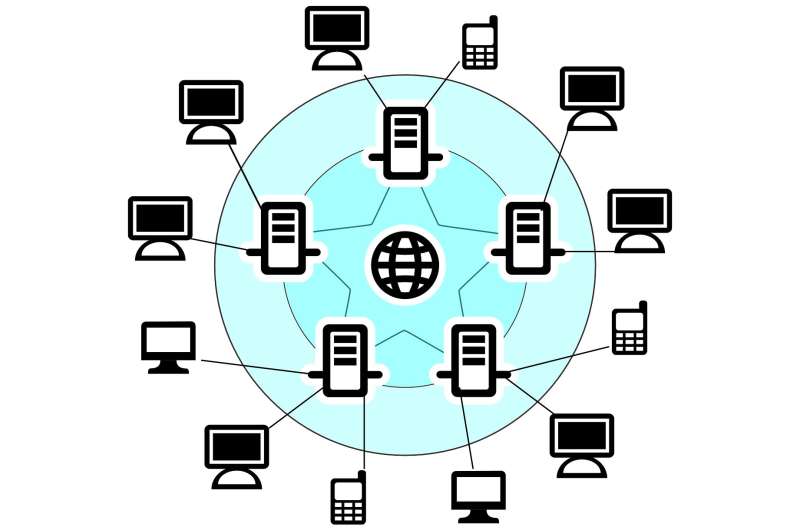A quantum cryptography network integrated in commercial optical network. Credit: Open ClipArt Vectors
Spanish researchers have developed a quantum cryptography network integrated in a commercial optical network through technologies based on software defined networking (SDN), allowing for the implementation of quantum and classical network services in a flexible, dynamic and scalable manner.
The network uses an infrastructure of fiber provided by Telefonica Spain that connects three facilities located in the metropolitan area of Madrid. The trial has been ongoing since last May, and a preliminary report was recently presented at QCRYPT2018, the largest conference in the field.
The network integrates quantum key distribution (QKD) devices developed by the Huawei Research Lab in Munich. Integrating all of the technological elements made it possible to demonstrate that QKD techniques can be applied in a real production environment, combining the transmission of data and quantum keys over the same fiber.
The management of the quantum and classical channels is done in an integrated way through SDN techniques, sharing the optical network in an optimal way. The fact that this has been developed on an existing infrastructure using standard communications systems highlights the maturity of this technology, which allows switching between links connecting points that may be up to 60 kilometers apart.
Twenty channels can share the same fiber in the same optical band that uses the quantum channel, allowing the simultaneous transmission of quantum signals with more than two terabytes per second of data in metropolitan area networks when using standard 100 gigabytes per second modules.
An advanced security quantum solution
Secure communications are based on cryptography, in which information is encrypted using a secret key. Only the users who know the decryption key can access the secret messages. The cryptographic techniques currently in use to exchange keys or electronically sign documents are based on mathematical problems that need excessive time to solve, prohibiting intrusions. However, as computing capacity increases, the time to solution is reduced, along with the security of these methods.
To avoid this problem, the size of the keys has had to increase as computing capacity has grown. These techniques may be rendered completely obsolete with the emergence of quantum computers that can solve currently intractable problems using the principles of quantum mechanics. These include breaking the keys generated by the most used cryptographic methods, making the majority of the communications security infrastructure useless.
Nevertheless, quantum technologies offer a solution to the vulnerability of current methods. With these technologies, it is possible to apply quantum principles to generate a secret key through a public communications channel, so that the key is secure against any attack, including one from a quantum computer. Quantum technology even make it possible to detect any attack attempt immediately.
Quantum technologies
Quantum key distribution is one of these technologies. Not only does it solve the problem of the threat posed by quantum computation to cryptographic key generation algorithms already in use, it can also provide a much higher level of security. QKD requires a physical infrastructure of optical fibers, such as that provided by Telefónica Spain used to connect the communication centers in the pilot program.
Until now, the viability of QKD has been demonstrated in laboratories and in controlled field trials, but there have always been problems with the ability to deploy it on a commercial infrastructure and to integrate it with the operating mechanisms of such a infrastructure. This experience demonstrates that it is possible to overcome those obstacles.
In the network, a new quantum technology has also been used for the distribution of quantum keys based on "continuous variables" QKD (CV-QKD) that is more compatible with classical technologies than existing ones. The combination of these technologies has enabled a complete integrated network of classical and quantum communications.
The deployment over an existing communications' infrastructure and the use of standard telecommunications systems that has been achieved in this trial is the first of its kind, demonstrating this technology's capacity for real-world use.
Provided by Center for Computational Simulation
























